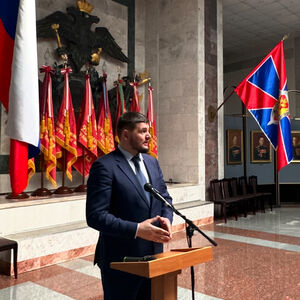Диссертация (1149360), страница 11
Текст из файла (страница 11)
Кроме того необходимо учитывать особенности формыпятна контакта.Результаты могут быть использованы для оценки эффектов, таких какизнос, связанных с анизотропией на поверхности, со спецификой области взаимодействия, а также с неравномерностью распределения давления.88СПИСОК ЛИТЕРАТУРЫ1. Amiri M., Khonsari Michael M. On the Thermodynamics of Friction and WearA Review // Entropy. 2010. Vol.
12. Pp. 1021–1049.2. Antoni N., Ligier J.-L., Saffre P., Pastor J. Asymmetric friction: Modelingand experiments. // Int.J.Eng. Sci. 2007. Vol. 45. Pp. 587–600.3. Argatov I.I. A discussion of the method of dimensionality reduction // Journalof Mechanical engineering science. 2015. Pp. 1–8.4. Bafekrpour E., Dyskin A., Pasternak E.
et al. Internally architectured materials with directionally asymmetric friction // Scientific Reports. 2015. Vol. 5.P. 10732 EP.5. Bluhm H., Schwarz U.D., Meyer K.-P., Wiesendanger R. Anisotropy of sliding friction on the triglycine sulfate (0 1 0) surface. // Applied Physics A:Materials Science Processing. 1995. Vol. 61, no. 5. Pp. 525–533.6.
Brookes C.A., Brookes E.J., Xing G. The effect of temperature on the deformation of diamond surfaces. // Mechanical Behavior of Diamond and OtherForms of Carbon. Symposium Mater. Res. Soc. / Ed. by M. Drory, D. Bogy,M. Donley, J. Field. Pittsburgh, USA: 1995. Pp. 59–71.7. Carbone G., Malchikov A., Ceccarelli M., Jatsun S. Design and Simulationof Kursk Robot for in-Pipe Inspection // Proceedings of the 10th IFToMMInternational Symposium on Science of Mechanisms and Machines.
Brasov,Romania: Springer, 2009. — October 12-15. Pp. 103–114.8. Chand N., Dwivedi U.K., Acharya S.K. Anisotropic abrasive wear behaviourof bamboo (Dentrocalamus strictus) // Wear. 2007. Vol. 262. Pp. 1031–1037.9. Cheng N., Ishigami G., Hawthorne S. et al. Design and Analysis of a Soft Mobile Robot Composed of Multiple Thermally Activated Joints Driven by a Single Actuator // Proc. of the 2010 IEEE International Conference on Roboticsand Automation.
Anchorage, Alaska, USA: 2010. — May 3-8. Pp. 5207–5212.10. Czichos H., Saito T., Smith L.E. Springer Handbook of Metrology and Testing. Berlin: Springer-Verlag Berlin Heidelberg, 2011. P. 1500.8911. Dickrell P.L., Sinnott S.B., Hahn D.W. et al. Frictional anisotropy of orientedcarbon nanotube surfaces // Tribology Letters. 2005.
Vol. 18. Pp. 59–62.12. Dmitriev N.N. Movement of the disk and the ring over the plane withanisotropic friction. // J.Fric. Wear. 2002. Vol. 23. Pp. 10–15.13. Dmitriev N.N. Sliding of a solid body supported by a round platform on a horizontal plane with orthotropic friction. Part 1. Regular load distribution. //J.Fric. Wear. 2009. Vol. 30, no. 4.
Pp. 227–234.14. Dmitriev N.N. Motion of material point and equilibrium of two-mass systemunder asymmetric orthotropic friction. // J.Fric. Wear. 2013. Vol. 34. Pp. 429–437.15. Dmitriev N.N. Motion of a narrow ring on a plane with asymmetric orthotropic friction. // J.Fric. Wear. 2015. Vol. 36. Pp. 80–88.16. Farkas Z., Bartels G., Unger T., Wolf D.E. Frictional coupling between slidingand spinning motion // Phys.
Rev. Lett. 2003. Vol. 90, no. 24. Pp. 248–302.17. Forbes A.B., Lam J., Tomlins P. Capturing local and anisotropic behaviourin surface topography // Wear. 2009. Vol. 266. Pp. 527–529.18. Goyal S. Planar sliding of a rigid body with dry friction: Limit surfaces anddynamics of motion: Ph. D. thesis / Cornell University, Ithaca. 1989.19. Grillo S.E., Field J.E., van Bouwelen F.M. Diamond polishing: the dependency of friction and wear on load and crystal orientation. // Journal of PhysicsD: Applied Physics. 2000. Vol.
33, no. 8. Pp. 985–990.20. He Q.-C., Curnier A. Anisotropic dry friction between two orthotropic surfacesundergoing large displacements // Journal of Mechanics, A/Solids. 1993.Vol. 12. Pp. 631–666.21. Henry A., Padilla II, Brad L. et al. Frictional performance and near-surfaceevolution of nanocrystalline Ni–Fe as governed by contact stress and slidingvelocity // Wear. 2013.
Vol. 297. Pp. 860–871.22. Hirano M., Shinjo K. Superlubricity and frictional anisotropy. // Wear. 1993.Vol. 168, no. 1-2. Pp. 121–125.23. Ishigami G., Overholt J., Iagnemma K. Multi-material anisotropic frictionwheels for omnidirectional ground vehicles // Journal of Robotics and Mechatronics.
2012. Vol. 24. Pp. 261–267.9024. Ishlinskii A.Yu., Sokolov B.N., Chernous’ko F.L. On the motion of plane bodies in the presence of dry friction // Izv. AN SSSR. MTT [Mechanics of Solids].1981. no. 4. Pp. 17–28.25. Kireenkov A.A., Semendyaev S.V., Filatov V.F. Experimental study of coupled two-dimensional models of sliding and spinning friction // Mechanics ofSolids. 2010.
Vol. 45. Pp. 921–930.26. Konyukhov A., Schweizerhof K. Covariant description for frictional contactproblems // Comput. Mech. 2005. Vol. 35. Pp. 190–213.27. Konyukhov A., Vielsack P., Schweizerhof K. On coupled models of anisotropiccontact surfaces and their experimental validation. // Wear. 2008.
Vol. 264.Pp. 579–588.28. Kudra G., Awrejcewicz J. Approximate modelling of resulting dry frictionforces and rolling resistance for elliptic contact shape // European Journal ofMechanics A/Solids. 2013. Vol. 42. Pp. 358–375.29. Kudra G., Awrejcewicz J. Application and experimental validation of newcomputational models of friction forces and rolling resistance // ACTA MECHANICA.
2015. Vol. 226. Pp. 2831–2848.30. Lopes D. S., Neptunem R. R., Ambrósio J. A., Silva M. T. A superellipsoidplane model for simulating foot-ground contact during human gait // Computer Methods in Biomechanics and Biomedical Engineering. 2015. Pp. 1–10.31. Lurye A.I. Analytical Mechanics. Berlin: Springer-Verlag Berlin Heidelberg,2002.32. Manesh K.K., Ramamoorthy B., Singaperumal M.
Numerical generation ofanisotropic 3D non-Gaussian engineering surfaces with specified 3D surfaceroughness parameters // Wear. 2010. Vol. 268. Pp. 1371–1379.33. Mroz Z., Stupkiewicz S. An anisotropic friction and wear model // Journalof Solid Structures. 1996. Vol. 31. Pp. 1113–1131.34. Persson B.N.J. Contact mechanics for randomly rough surfaces // Surfacescience reports.
2006. Vol. 61. Pp. 201–227.35. Persson B.N.J. Capillary adhesion between elastic solids with randomly roughsurfaces // Phys.: Condens. Matter. 2008. Vol. 20. Pp. 1–13.36. Piotrowski J., Chollet H. Wheel-rail contact models for vehicle system dynamics including multi-point contact // Vehicle Syst. Dyn. 2005. Vol. 43, no.6-7. Pp.
455–483.9137. Popov V.L. Method of reduction of dimensionality in contact and frictionmechanics: A linkage between micro and macro scales // Friction. 2013.Vol. 1, no. 1. Pp. 41–62.38. Rozenblat G.M. Dynamical Systems with Dry Friction. Moscow-Izhevsk: NITsRegular and Chaotic Dynamics, 2006.
P. 204.39. Sichani M.Sh., Enblom R., Berg M. Comparison of non-elliptic contact models: Towards fast and accurate modelling of wheel–rail contact // Wear. 2014.Vol. 314, no. 1–2. Pp. 111 – 117.40. So E., Demirel M.C., Wahl K.J. Mechanical anisotropy of nanostructuredparylene films during sliding contact // J. Phys. D: Appl. Phys. 2010. Vol. 43.P. 045403.41. von der Ohe C.B., Johnsen R., Espallargas N. Multi-degradation behavior ofaustenitic and super duplex stainless steel - The effect of 4-point static andcyclic bending applied to a simulated seawater tribocorrosion system // Wear.2012. Vol.
288. Pp. 39–53.42. Voyenli K., Eriksen E. On the motion of an ice hockey puck // Amer. J. Phys.1985. Vol. 53. Pp. 1149–1153.43. Waidman P.D., Malhotra Ch.P. On the Terminal Motion of Sliding SpinningDisks with Uniform Coulomb Friction. // Phys. D. 2007. Vol. 233, no. 1.Pp. 1–13.44. Yu Chengjiao, Jane Wang Q. Friction Anisotropy with Respect to Topographic Orientation // Scientific Reports. 2012. Vol. 988. Pp. 1–6.45.
Zmitrowicz A. A theoretical model of anisotropic dry friction. // Wear. 1981.Vol. 73. Pp. 9–39.46. Zmitrowicz A. Mathematical descriptions of anisotropic friction. //Int.J.Solids Struct. 1989. Vol. 25, no. 8. Pp. 837–862.47. Zmitrowicz A. A constitutive modeling of centrosymmetric and noncentrosymmetric anisotropic friction. // Int.J.Solids Struct. 1992. Vol. 29.Pp. 3025–3043.48. Zmitrowicz A. Illustrative examples of centrosymmetric and noncentrosymmetric anisotropic friction.
// Int.J.Solids Struct. 1992. Vol. 29,no. 23. Pp. 3045–3059.9249. Zmitrowicz A. Models of kinematic dependent anisotropic and heterogeneousfriction. // Int.J.Solids Struct. 2005. Vol. 43. Pp. 4407–4451.50. Александрович А.И., Векшин В.С., Потапов И.Н. Тензор коэффициентовтрения анизотропных поверхностей // Трение и износ. 1985. Vol.
VI.Pp. 996–1004.51. Андронов В.В. Журавлёв В.Ф. Сухое трение в задачах механики. М.Ижевск: НИЦ «Регулярная и хаотическая динамика», 2010. P. 184.52. Аргатов И.И. Условия равновесия твёрдого тела на шероховатойплоскости при осесимметричном распределении нормальных давлений //Механика твёрдого тела. 2005. no. 2. Pp.
















